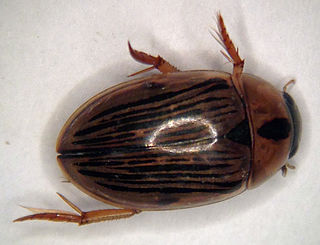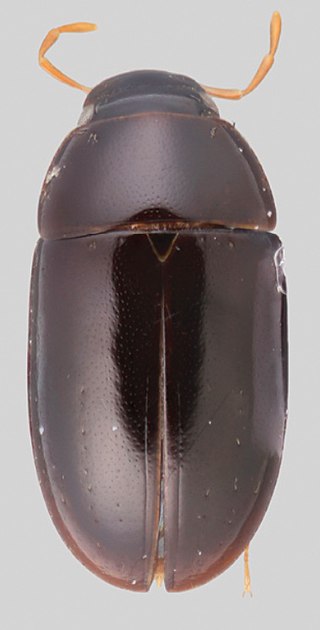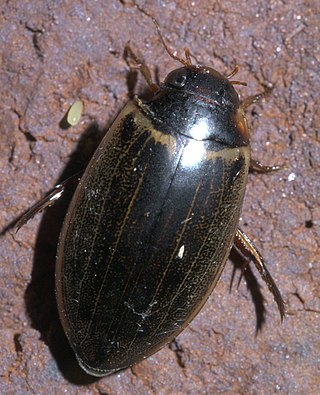
The Dytiscidae – based on the Greek dytikos (δυτικός), "able to dive" – are the predaceous diving beetles, a family of water beetles. They occur in virtually any freshwater habitat around the world, but a few species live among leaf litter. The adults of most are between 1 and 2.5 cm (0.4–1.0 in) long, though much variation is seen between species. The European Dytiscus latissimus and Brazilian Megadytes ducalis are the largest, reaching up to 4.5 cm (1.8 in) and 4.75 cm (1.9 in) respectively. In contrast, the smallest is likely the Australian Limbodessus atypicali of subterranean waters, which only is about 0.9 mm (0.035 in) long. Most are dark brown, blackish, or dark olive in color with golden highlights in some subfamilies. The larvae are commonly known as water tigers due to their voracious appetite. They have short, but sharp mandibles and immediately upon biting, they deliver digestive enzymes into prey to suck their liquefied remains. The family includes more than 4,000 described species in numerous genera.

The Neotropical fruit bats (Artibeus) are a genus of bats within the subfamily Stenodermatinae. The genus consists of 12 species, which are native to Central and South America, as well as the Caribbean.

Megadytes is a genus of diving beetles in the family Dytiscidae. They are found in slow-moving or static freshwater habitats in the Neotropics. The adult beetles measure about 1.65–4.75 cm (0.6–1.9 in) long depending on the exact species and the largest is also the largest in the family.

The minute tree-fungus beetles, family Ciidae, are a sizeable group of beetles which inhabit Polyporales bracket fungi or coarse woody debris. Most numerous in warmer regions, they are nonetheless widespread and a considerable number of species occur as far polewards as Scandinavia for example.

Agabus is a large genus of predatory aquatic beetles in the family Dytiscidae, proposed in 1817 by William Elford Leach and named after Agabus, an early follower of Christianity. The adult beetles are moderate-sized, 5 to 14 mm long. The genus is primarily Holarctic in distribution, with only a few species known from the Afrotropical and Neotropical realms. Three species of Agabus, namely A. clypealis, A. discicollis and A. hozgargantae are endangered according to the IUCN Red List. The division into subgenera is not widely accepted. However, a number of species groups are recognized after the works of David J. Larson and Anders N. Nilsson. The genus is probably polyphyletic or paraphyletic. In a recent study of mitochondrial DNA, Agabus was found paraphyletic with respect to several of the species groups of Platambus, a closely related genus in the tribe Agabini. Lately the taxonomy of the genus has been revised, and some groups of species were transferred from Agabussensu stricto to other genera in the tribe Agabini.

Cybister, is a genus of beetle in family Dytiscidae. They are found in much of the world, including all continents except Antarctica. As of 2021 there are 96 species and 9 additional subspecies among four subgenera in the genus.

Bifurcitus lherminieri, formerly Megadytes lherminieri, is a species in the genus Bifurcitus of large diving beetles found in the Neotropics.

Hydroglyphus is a genus of predaceous diving beetles in the family Dytiscidae. There are more than 90 described species in Hydroglyphus, found in Africa, Australasia, Indomalaya, and the Palearctic.
Queda is a genus of predaceous diving beetles in the family Dytiscidae. There are at least three described species in Queda, found in the Neotropics.

Leptochirus is a genus of beetles in the family Staphylinidae, the rove beetles.

Tropisternus is a genus of hydrophilid beetles with 63 species in five subgenera in North and South America.

Chasmogenus is a Neotropical genus of water scavenger beetles belonging to the family Hydrophilidae.

Cybistrini is a tribe of predaceous diving beetles in the family Dytiscidae. There are 12 genera and 130 described extant species in Cybistrini. The same set is also called Cybistrinae by authors viewing it as a subfamily of Dytiscidae.

Meridiorhantus is a genus of predaceous diving beetles in the family Dytiscidae. There are about five described species in Meridiorhantus, found in the Neotropics and North America. These species were formerly members of the genus Rhantus, but were moved to Meridiorhantus when it was created by Balke et al. in 2017.

Sindolus is a Neotropical genus of water scavenger beetles in the family Hydrophilidae represented by eight described species, ranging from Mexico to Argentina, and including one species recorded from Antigua in the Lesser Antilles.
Bifurcitus is a genus of beetles in the dytiscid subfamily Cybistrinae that occur in the Neotropics. The genus contains three species, two extant and one presumed extinct; they were previously classified in the genus Megadytes.
Bifurcitus magnus is a species of beetles in the dytiscid subfamily Cybistrinae that occurs in South America.
Paramegadytes is a genus of beetles in the dytiscid subfamily Cybistrinae that occur in the Neotropics. The genus contains two species that were previously classified in the genus Megadytes.
Trifurcitus is a genus of beetles in the dytiscid subfamily Cybistrinae that occur in the Neotropics. The genus contains six species that were previously classified in the genus Megadytes.
Nilssondytes is a genus of predaceous diving beetles in the family Dytiscidae. Following reclassification of the subfamily Cybistrinae in 2024, only a single species, N. diversus, is included in the genus.













